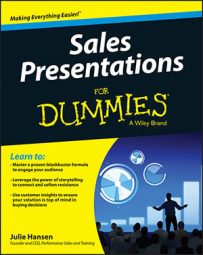You need a sales presentation with a persuasive structure that leads to action. Hordes of data sandwiched between a company overview and an awkward "any questions?" closing neither engages nor persuades today's prospects.
Hook them with the opening
Fair or not, during those critical first few seconds during your opening, your prospect is evaluating you, making decisions about how and whether they are going to listen to you. In fact, research has found that the majority of jurors decides on the verdict — and sticks with it — during the opening arguments. Although you're not on trial, you need to know what you need to accomplish with your opening:
Capture attention. Use a relevant opening hook — something that makes your prospect put down his smartphone and pay attention, like a story, a quote, or an insight — to get off to a strong start.
Define the situation. Quickly comparing how your prospect is dealing with the problem to what your prospect's situation looks like after the problem is resolved gives your prospect a reminder of why you're there and a vision of where you're headed.
Establish value. Busy prospects hate to have their time wasted. Giving them a sense of value initially is critical to gain early buy-in.
Sell the next minute. Like many movie previews, too many salespeople reveal the whole plot in their opening. Keep interest and attention high by holding something back to keep your prospect tuned.
Seem like a tall order for the top of your presentation? You bet it is. Don't leave your opening to chance. The sale could be riding on it.
Create tension in the body
The body of most sales presentations is made up almost entirely of a long list of features that leave your prospect longing for a fire drill. In a persuasive presentation, use the body to build tension by exploring the gap between your prospect's current situation and where they want to be. Here's why:
Establish priority: Prospects often have competing priorities. You need to make a case for why yours should take precedence.
Avoid pain: Research proves that people are much more willing to take a risk to avoid pain than to embrace an opportunity.
Fight the status quo: Getting prospects to move off an "If it ain't too broke, don't fix it" mentality requires cranking up the heat well before you get to the closing.
Resolve with a solution
Every presentation ends, but very few close. A good closing resolves the tension and makes it easy for your prospect to take the next step. Afraid of being repetitive or sensing real or imagined impatience, salespeople often rush to wrap up things and skip or mumble through vague next steps.
As the final impression you make on your prospect, closings must shine as brightly as your opening, provide value, and give a clear and measurable call to action.

